PROJ 6006 Case Study: Leadership & Management Approaches at EWS
VerifiedAdded on 2022/10/14
|11
|2526
|496
Case Study
AI Summary
This case study examines the leadership approaches employed by Ecological Wastewater Solutions Pty Ltd (EWS), a wastewater management company. It discusses the leadership styles, project management tools, and techniques used to influence the project team and manage external communication. The analysis covers the application of PERT and CPM charts, communication plans, and the five types of power to motivate team members. It also explores the use of self-managed teams for agile projects and the reasons for choosing specific approaches. The study identifies potential challenges faced by leaders and provides recommendations for alleviating these challenges, emphasizing the importance of strong leadership skills for organizational success. The report concludes that EWS has a promising system for wastewater treatment and advocates for continuous improvement and adaptation to overcome future obstacles.
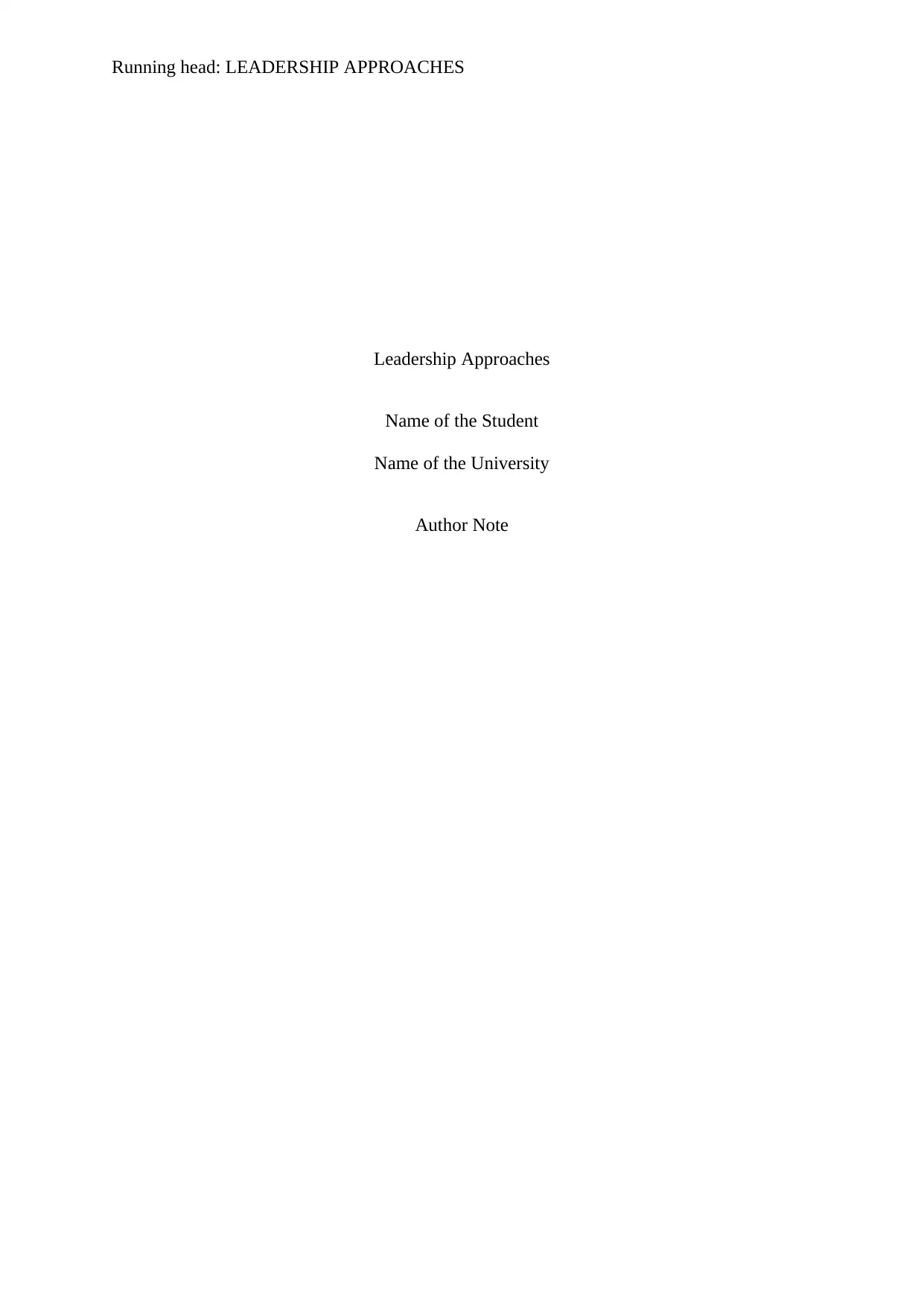
Running head: LEADERSHIP APPROACHES
Leadership Approaches
Name of the Student
Name of the University
Author Note
Leadership Approaches
Name of the Student
Name of the University
Author Note
Paraphrase This Document
Need a fresh take? Get an instant paraphrase of this document with our AI Paraphraser
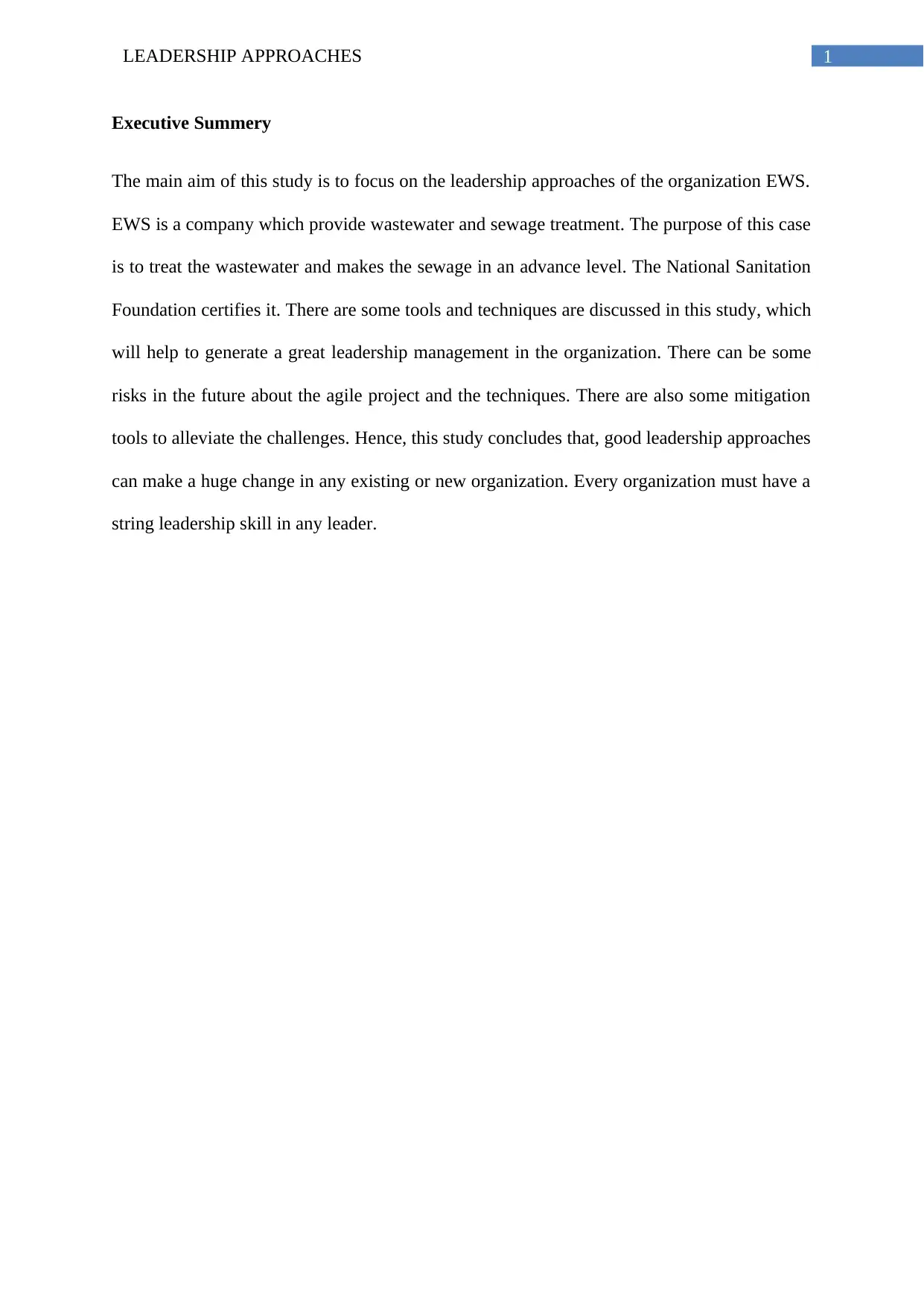
1LEADERSHIP APPROACHES
Executive Summery
The main aim of this study is to focus on the leadership approaches of the organization EWS.
EWS is a company which provide wastewater and sewage treatment. The purpose of this case
is to treat the wastewater and makes the sewage in an advance level. The National Sanitation
Foundation certifies it. There are some tools and techniques are discussed in this study, which
will help to generate a great leadership management in the organization. There can be some
risks in the future about the agile project and the techniques. There are also some mitigation
tools to alleviate the challenges. Hence, this study concludes that, good leadership approaches
can make a huge change in any existing or new organization. Every organization must have a
string leadership skill in any leader.
Executive Summery
The main aim of this study is to focus on the leadership approaches of the organization EWS.
EWS is a company which provide wastewater and sewage treatment. The purpose of this case
is to treat the wastewater and makes the sewage in an advance level. The National Sanitation
Foundation certifies it. There are some tools and techniques are discussed in this study, which
will help to generate a great leadership management in the organization. There can be some
risks in the future about the agile project and the techniques. There are also some mitigation
tools to alleviate the challenges. Hence, this study concludes that, good leadership approaches
can make a huge change in any existing or new organization. Every organization must have a
string leadership skill in any leader.
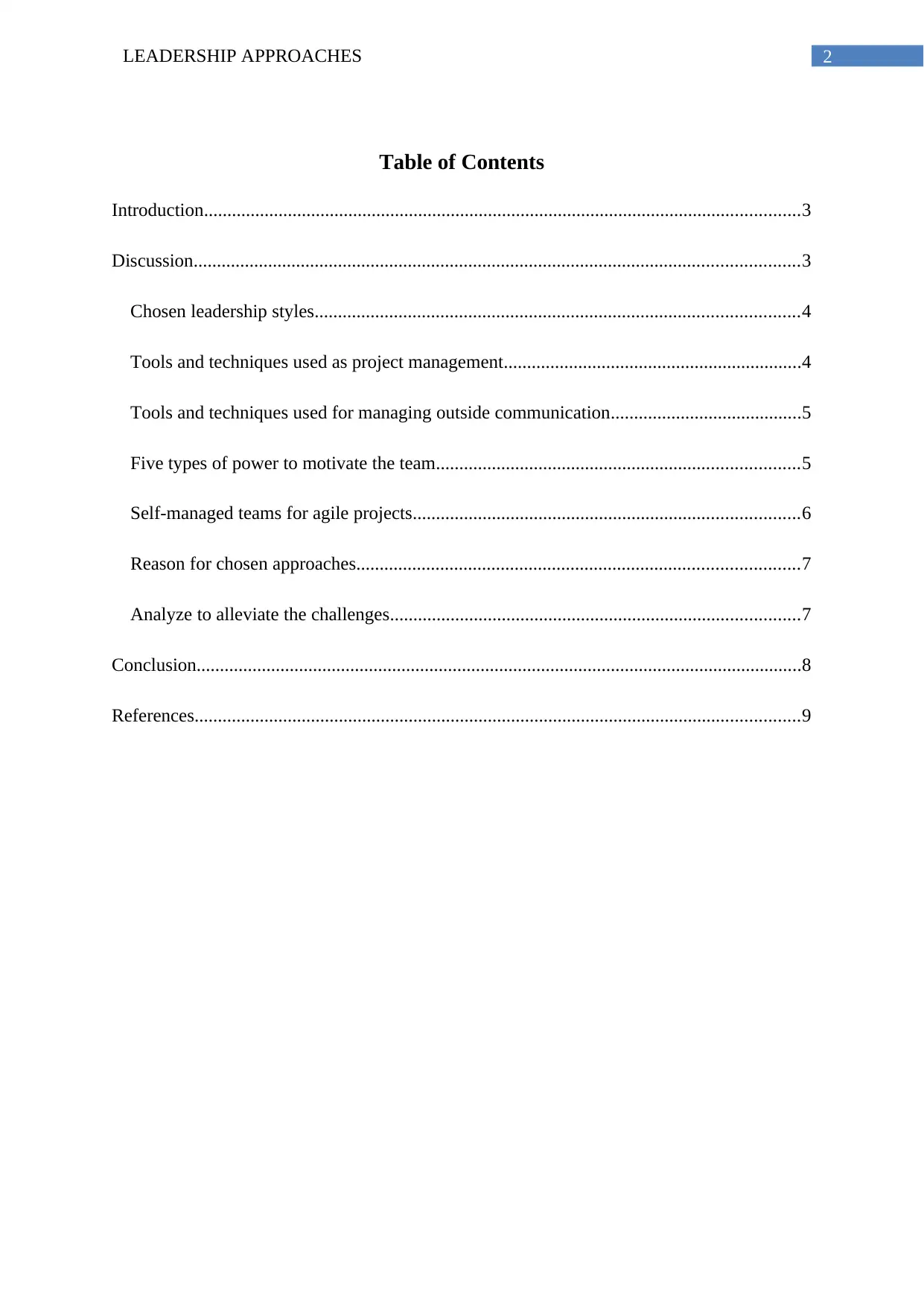
2LEADERSHIP APPROACHES
Table of Contents
Introduction................................................................................................................................3
Discussion..................................................................................................................................3
Chosen leadership styles........................................................................................................4
Tools and techniques used as project management................................................................4
Tools and techniques used for managing outside communication.........................................5
Five types of power to motivate the team..............................................................................5
Self-managed teams for agile projects...................................................................................6
Reason for chosen approaches...............................................................................................7
Analyze to alleviate the challenges........................................................................................7
Conclusion..................................................................................................................................8
References..................................................................................................................................9
Table of Contents
Introduction................................................................................................................................3
Discussion..................................................................................................................................3
Chosen leadership styles........................................................................................................4
Tools and techniques used as project management................................................................4
Tools and techniques used for managing outside communication.........................................5
Five types of power to motivate the team..............................................................................5
Self-managed teams for agile projects...................................................................................6
Reason for chosen approaches...............................................................................................7
Analyze to alleviate the challenges........................................................................................7
Conclusion..................................................................................................................................8
References..................................................................................................................................9
⊘ This is a preview!⊘
Do you want full access?
Subscribe today to unlock all pages.

Trusted by 1+ million students worldwide
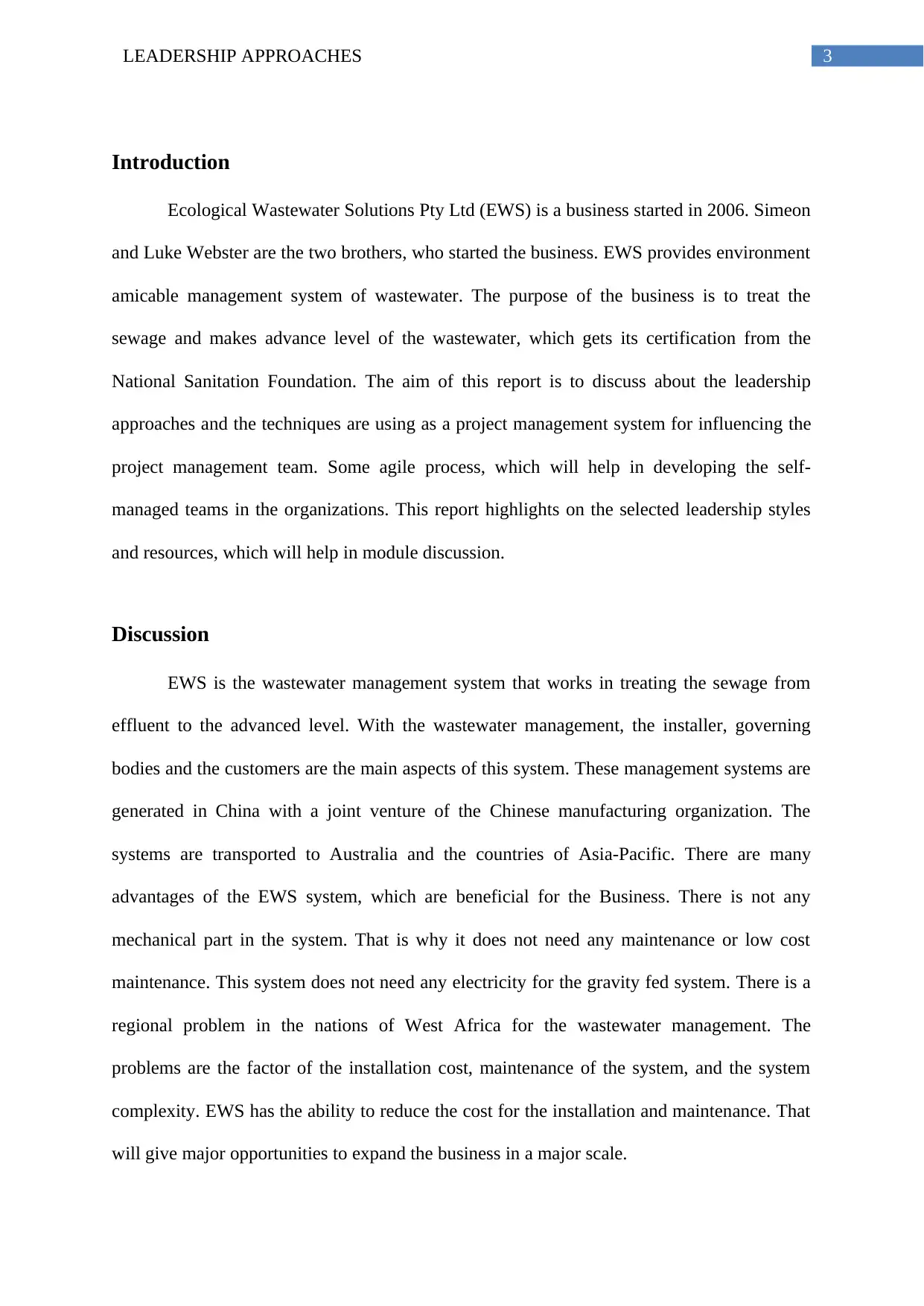
3LEADERSHIP APPROACHES
Introduction
Ecological Wastewater Solutions Pty Ltd (EWS) is a business started in 2006. Simeon
and Luke Webster are the two brothers, who started the business. EWS provides environment
amicable management system of wastewater. The purpose of the business is to treat the
sewage and makes advance level of the wastewater, which gets its certification from the
National Sanitation Foundation. The aim of this report is to discuss about the leadership
approaches and the techniques are using as a project management system for influencing the
project management team. Some agile process, which will help in developing the self-
managed teams in the organizations. This report highlights on the selected leadership styles
and resources, which will help in module discussion.
Discussion
EWS is the wastewater management system that works in treating the sewage from
effluent to the advanced level. With the wastewater management, the installer, governing
bodies and the customers are the main aspects of this system. These management systems are
generated in China with a joint venture of the Chinese manufacturing organization. The
systems are transported to Australia and the countries of Asia-Pacific. There are many
advantages of the EWS system, which are beneficial for the Business. There is not any
mechanical part in the system. That is why it does not need any maintenance or low cost
maintenance. This system does not need any electricity for the gravity fed system. There is a
regional problem in the nations of West Africa for the wastewater management. The
problems are the factor of the installation cost, maintenance of the system, and the system
complexity. EWS has the ability to reduce the cost for the installation and maintenance. That
will give major opportunities to expand the business in a major scale.
Introduction
Ecological Wastewater Solutions Pty Ltd (EWS) is a business started in 2006. Simeon
and Luke Webster are the two brothers, who started the business. EWS provides environment
amicable management system of wastewater. The purpose of the business is to treat the
sewage and makes advance level of the wastewater, which gets its certification from the
National Sanitation Foundation. The aim of this report is to discuss about the leadership
approaches and the techniques are using as a project management system for influencing the
project management team. Some agile process, which will help in developing the self-
managed teams in the organizations. This report highlights on the selected leadership styles
and resources, which will help in module discussion.
Discussion
EWS is the wastewater management system that works in treating the sewage from
effluent to the advanced level. With the wastewater management, the installer, governing
bodies and the customers are the main aspects of this system. These management systems are
generated in China with a joint venture of the Chinese manufacturing organization. The
systems are transported to Australia and the countries of Asia-Pacific. There are many
advantages of the EWS system, which are beneficial for the Business. There is not any
mechanical part in the system. That is why it does not need any maintenance or low cost
maintenance. This system does not need any electricity for the gravity fed system. There is a
regional problem in the nations of West Africa for the wastewater management. The
problems are the factor of the installation cost, maintenance of the system, and the system
complexity. EWS has the ability to reduce the cost for the installation and maintenance. That
will give major opportunities to expand the business in a major scale.
Paraphrase This Document
Need a fresh take? Get an instant paraphrase of this document with our AI Paraphraser
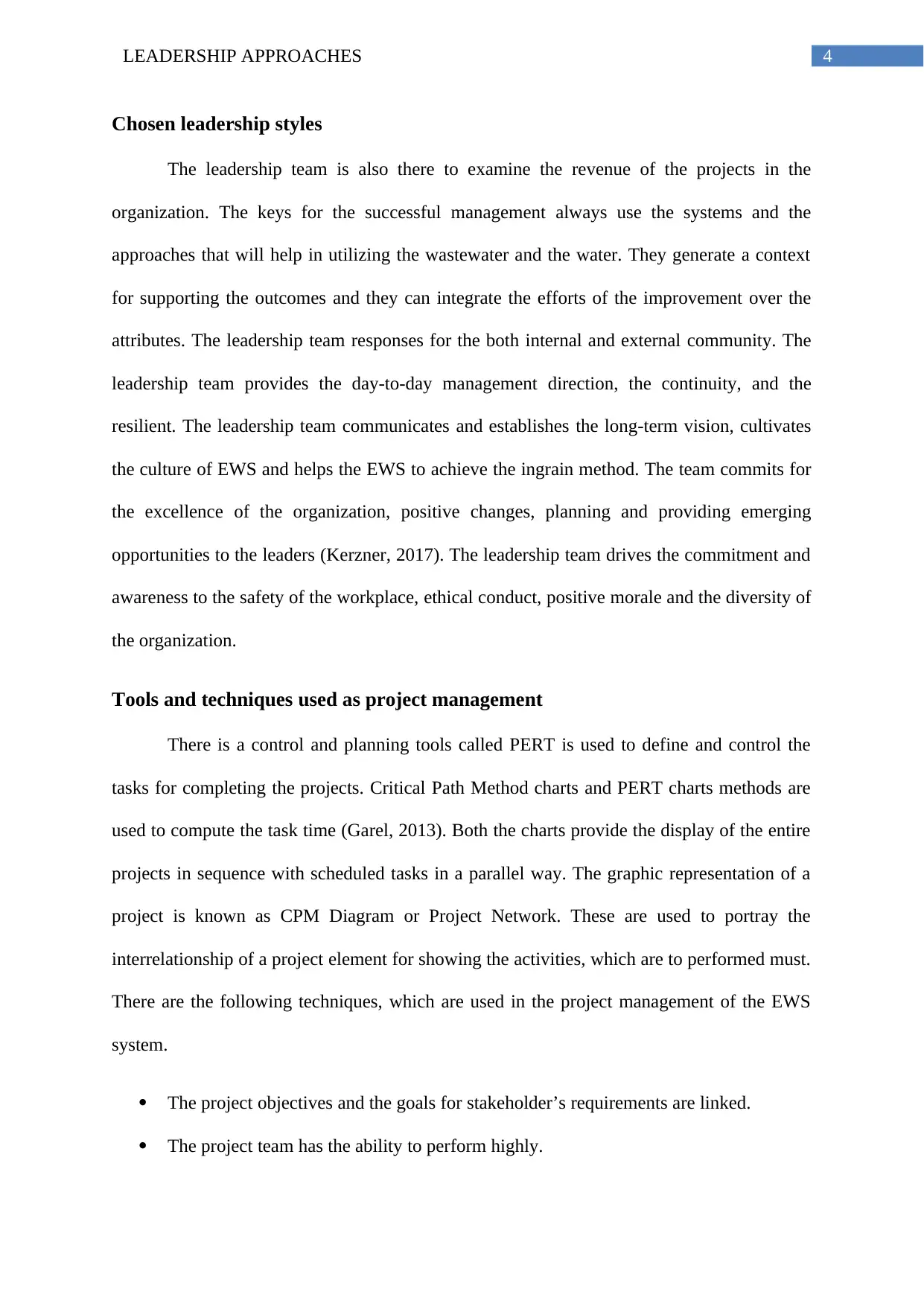
4LEADERSHIP APPROACHES
Chosen leadership styles
The leadership team is also there to examine the revenue of the projects in the
organization. The keys for the successful management always use the systems and the
approaches that will help in utilizing the wastewater and the water. They generate a context
for supporting the outcomes and they can integrate the efforts of the improvement over the
attributes. The leadership team responses for the both internal and external community. The
leadership team provides the day-to-day management direction, the continuity, and the
resilient. The leadership team communicates and establishes the long-term vision, cultivates
the culture of EWS and helps the EWS to achieve the ingrain method. The team commits for
the excellence of the organization, positive changes, planning and providing emerging
opportunities to the leaders (Kerzner, 2017). The leadership team drives the commitment and
awareness to the safety of the workplace, ethical conduct, positive morale and the diversity of
the organization.
Tools and techniques used as project management
There is a control and planning tools called PERT is used to define and control the
tasks for completing the projects. Critical Path Method charts and PERT charts methods are
used to compute the task time (Garel, 2013). Both the charts provide the display of the entire
projects in sequence with scheduled tasks in a parallel way. The graphic representation of a
project is known as CPM Diagram or Project Network. These are used to portray the
interrelationship of a project element for showing the activities, which are to performed must.
There are the following techniques, which are used in the project management of the EWS
system.
The project objectives and the goals for stakeholder’s requirements are linked.
The project team has the ability to perform highly.
Chosen leadership styles
The leadership team is also there to examine the revenue of the projects in the
organization. The keys for the successful management always use the systems and the
approaches that will help in utilizing the wastewater and the water. They generate a context
for supporting the outcomes and they can integrate the efforts of the improvement over the
attributes. The leadership team responses for the both internal and external community. The
leadership team provides the day-to-day management direction, the continuity, and the
resilient. The leadership team communicates and establishes the long-term vision, cultivates
the culture of EWS and helps the EWS to achieve the ingrain method. The team commits for
the excellence of the organization, positive changes, planning and providing emerging
opportunities to the leaders (Kerzner, 2017). The leadership team drives the commitment and
awareness to the safety of the workplace, ethical conduct, positive morale and the diversity of
the organization.
Tools and techniques used as project management
There is a control and planning tools called PERT is used to define and control the
tasks for completing the projects. Critical Path Method charts and PERT charts methods are
used to compute the task time (Garel, 2013). Both the charts provide the display of the entire
projects in sequence with scheduled tasks in a parallel way. The graphic representation of a
project is known as CPM Diagram or Project Network. These are used to portray the
interrelationship of a project element for showing the activities, which are to performed must.
There are the following techniques, which are used in the project management of the EWS
system.
The project objectives and the goals for stakeholder’s requirements are linked.
The project team has the ability to perform highly.
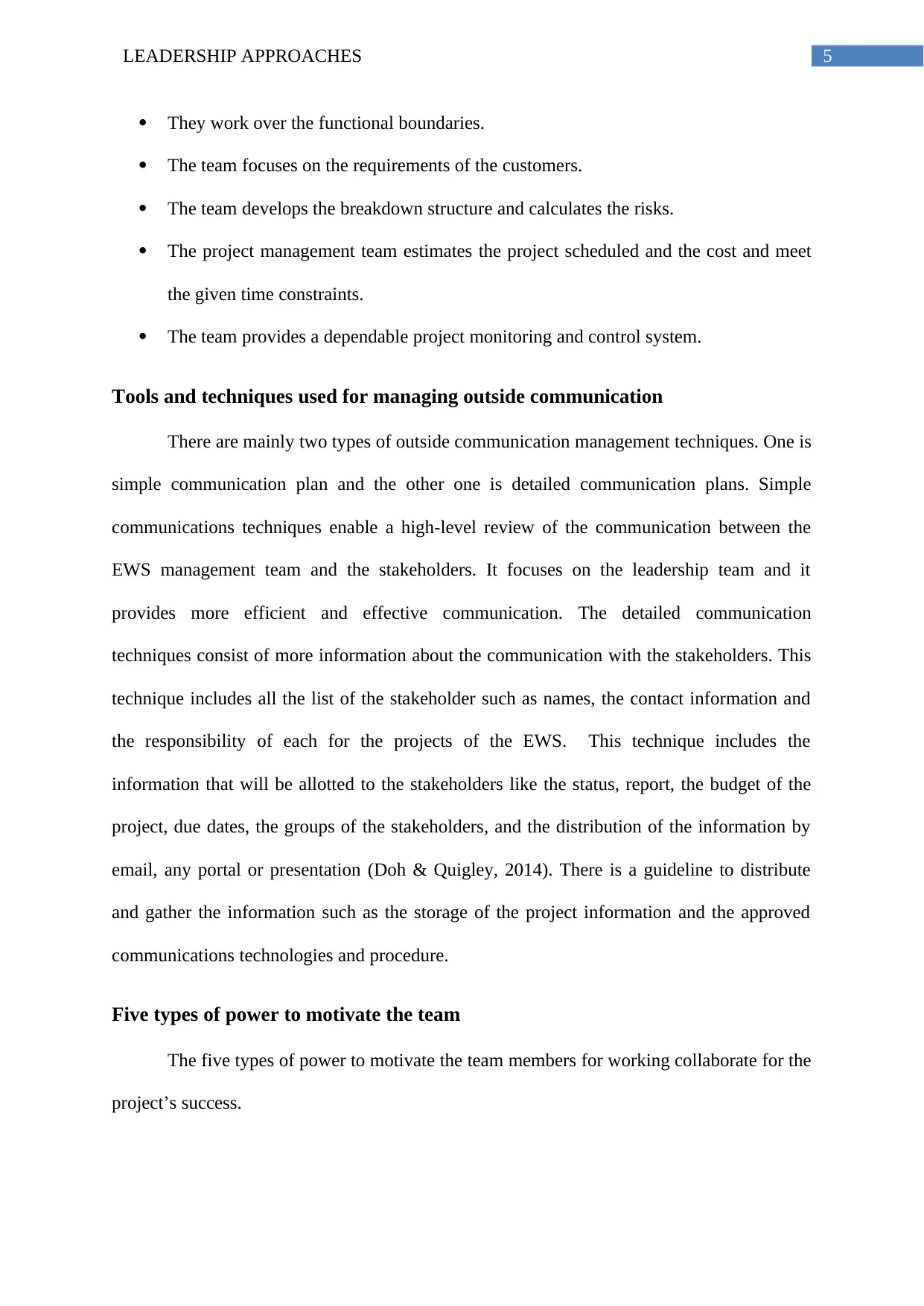
5LEADERSHIP APPROACHES
They work over the functional boundaries.
The team focuses on the requirements of the customers.
The team develops the breakdown structure and calculates the risks.
The project management team estimates the project scheduled and the cost and meet
the given time constraints.
The team provides a dependable project monitoring and control system.
Tools and techniques used for managing outside communication
There are mainly two types of outside communication management techniques. One is
simple communication plan and the other one is detailed communication plans. Simple
communications techniques enable a high-level review of the communication between the
EWS management team and the stakeholders. It focuses on the leadership team and it
provides more efficient and effective communication. The detailed communication
techniques consist of more information about the communication with the stakeholders. This
technique includes all the list of the stakeholder such as names, the contact information and
the responsibility of each for the projects of the EWS. This technique includes the
information that will be allotted to the stakeholders like the status, report, the budget of the
project, due dates, the groups of the stakeholders, and the distribution of the information by
email, any portal or presentation (Doh & Quigley, 2014). There is a guideline to distribute
and gather the information such as the storage of the project information and the approved
communications technologies and procedure.
Five types of power to motivate the team
The five types of power to motivate the team members for working collaborate for the
project’s success.
They work over the functional boundaries.
The team focuses on the requirements of the customers.
The team develops the breakdown structure and calculates the risks.
The project management team estimates the project scheduled and the cost and meet
the given time constraints.
The team provides a dependable project monitoring and control system.
Tools and techniques used for managing outside communication
There are mainly two types of outside communication management techniques. One is
simple communication plan and the other one is detailed communication plans. Simple
communications techniques enable a high-level review of the communication between the
EWS management team and the stakeholders. It focuses on the leadership team and it
provides more efficient and effective communication. The detailed communication
techniques consist of more information about the communication with the stakeholders. This
technique includes all the list of the stakeholder such as names, the contact information and
the responsibility of each for the projects of the EWS. This technique includes the
information that will be allotted to the stakeholders like the status, report, the budget of the
project, due dates, the groups of the stakeholders, and the distribution of the information by
email, any portal or presentation (Doh & Quigley, 2014). There is a guideline to distribute
and gather the information such as the storage of the project information and the approved
communications technologies and procedure.
Five types of power to motivate the team
The five types of power to motivate the team members for working collaborate for the
project’s success.
⊘ This is a preview!⊘
Do you want full access?
Subscribe today to unlock all pages.

Trusted by 1+ million students worldwide
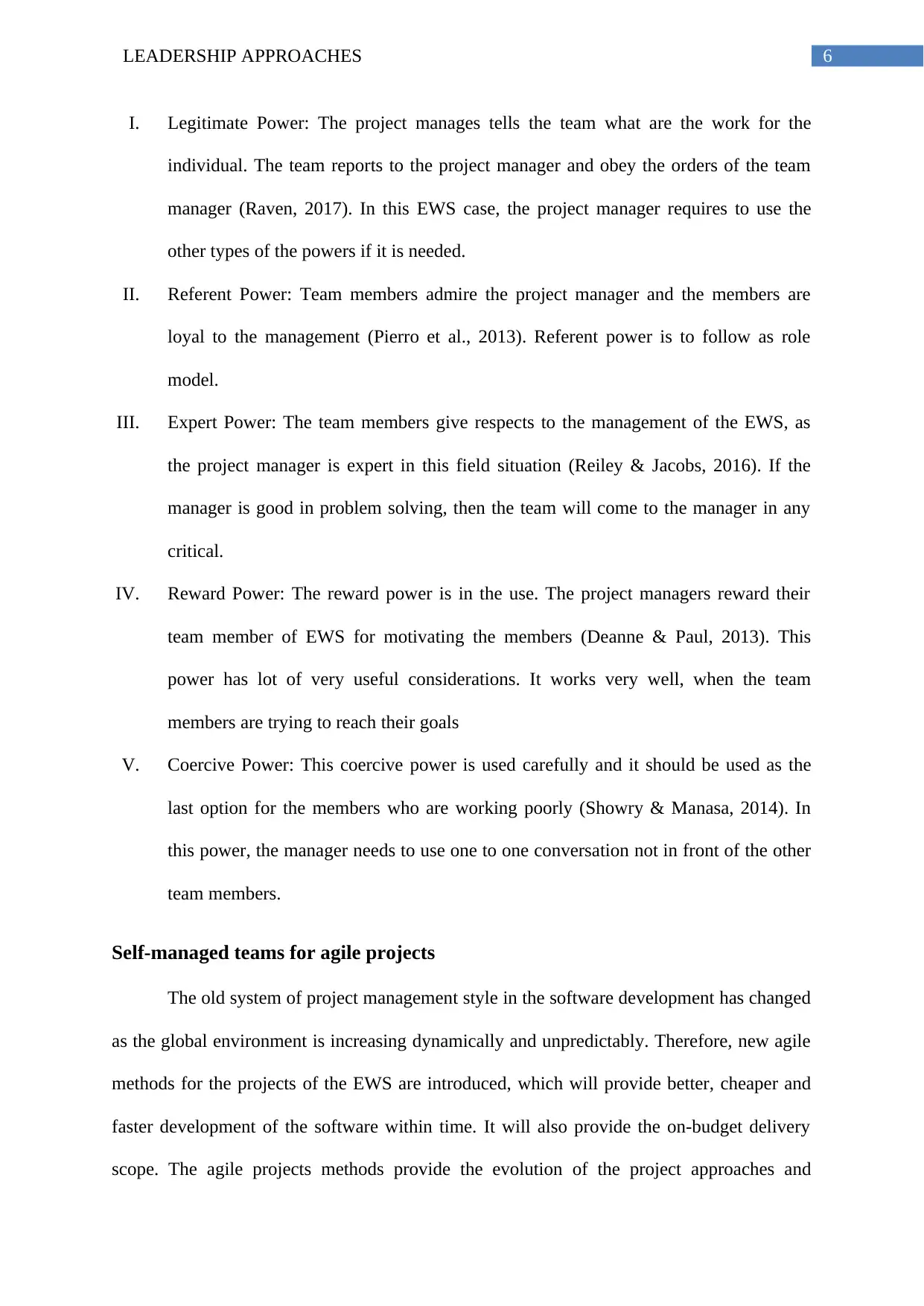
6LEADERSHIP APPROACHES
I. Legitimate Power: The project manages tells the team what are the work for the
individual. The team reports to the project manager and obey the orders of the team
manager (Raven, 2017). In this EWS case, the project manager requires to use the
other types of the powers if it is needed.
II. Referent Power: Team members admire the project manager and the members are
loyal to the management (Pierro et al., 2013). Referent power is to follow as role
model.
III. Expert Power: The team members give respects to the management of the EWS, as
the project manager is expert in this field situation (Reiley & Jacobs, 2016). If the
manager is good in problem solving, then the team will come to the manager in any
critical.
IV. Reward Power: The reward power is in the use. The project managers reward their
team member of EWS for motivating the members (Deanne & Paul, 2013). This
power has lot of very useful considerations. It works very well, when the team
members are trying to reach their goals
V. Coercive Power: This coercive power is used carefully and it should be used as the
last option for the members who are working poorly (Showry & Manasa, 2014). In
this power, the manager needs to use one to one conversation not in front of the other
team members.
Self-managed teams for agile projects
The old system of project management style in the software development has changed
as the global environment is increasing dynamically and unpredictably. Therefore, new agile
methods for the projects of the EWS are introduced, which will provide better, cheaper and
faster development of the software within time. It will also provide the on-budget delivery
scope. The agile projects methods provide the evolution of the project approaches and
I. Legitimate Power: The project manages tells the team what are the work for the
individual. The team reports to the project manager and obey the orders of the team
manager (Raven, 2017). In this EWS case, the project manager requires to use the
other types of the powers if it is needed.
II. Referent Power: Team members admire the project manager and the members are
loyal to the management (Pierro et al., 2013). Referent power is to follow as role
model.
III. Expert Power: The team members give respects to the management of the EWS, as
the project manager is expert in this field situation (Reiley & Jacobs, 2016). If the
manager is good in problem solving, then the team will come to the manager in any
critical.
IV. Reward Power: The reward power is in the use. The project managers reward their
team member of EWS for motivating the members (Deanne & Paul, 2013). This
power has lot of very useful considerations. It works very well, when the team
members are trying to reach their goals
V. Coercive Power: This coercive power is used carefully and it should be used as the
last option for the members who are working poorly (Showry & Manasa, 2014). In
this power, the manager needs to use one to one conversation not in front of the other
team members.
Self-managed teams for agile projects
The old system of project management style in the software development has changed
as the global environment is increasing dynamically and unpredictably. Therefore, new agile
methods for the projects of the EWS are introduced, which will provide better, cheaper and
faster development of the software within time. It will also provide the on-budget delivery
scope. The agile projects methods provide the evolution of the project approaches and
Paraphrase This Document
Need a fresh take? Get an instant paraphrase of this document with our AI Paraphraser
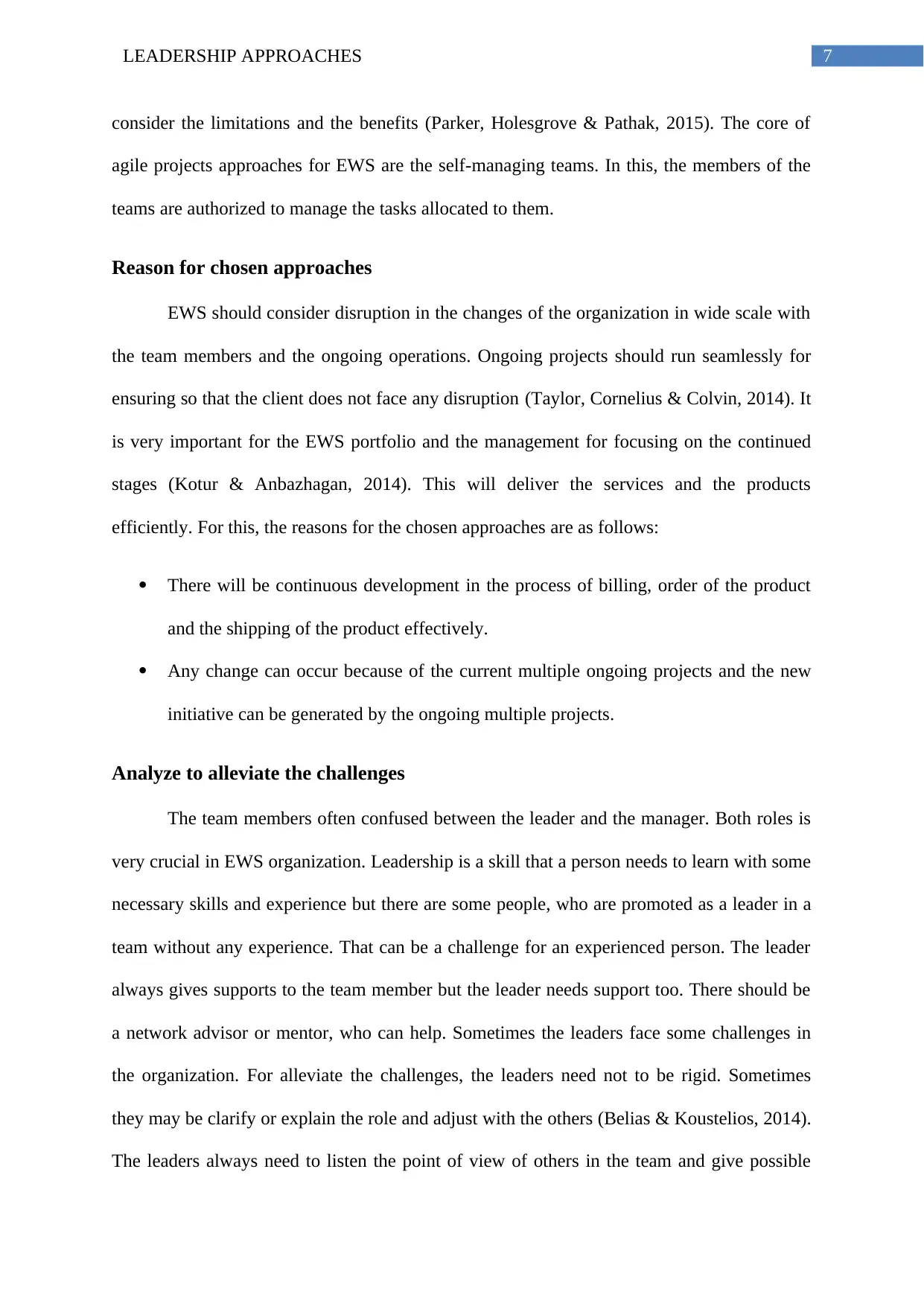
7LEADERSHIP APPROACHES
consider the limitations and the benefits (Parker, Holesgrove & Pathak, 2015). The core of
agile projects approaches for EWS are the self-managing teams. In this, the members of the
teams are authorized to manage the tasks allocated to them.
Reason for chosen approaches
EWS should consider disruption in the changes of the organization in wide scale with
the team members and the ongoing operations. Ongoing projects should run seamlessly for
ensuring so that the client does not face any disruption (Taylor, Cornelius & Colvin, 2014). It
is very important for the EWS portfolio and the management for focusing on the continued
stages (Kotur & Anbazhagan, 2014). This will deliver the services and the products
efficiently. For this, the reasons for the chosen approaches are as follows:
There will be continuous development in the process of billing, order of the product
and the shipping of the product effectively.
Any change can occur because of the current multiple ongoing projects and the new
initiative can be generated by the ongoing multiple projects.
Analyze to alleviate the challenges
The team members often confused between the leader and the manager. Both roles is
very crucial in EWS organization. Leadership is a skill that a person needs to learn with some
necessary skills and experience but there are some people, who are promoted as a leader in a
team without any experience. That can be a challenge for an experienced person. The leader
always gives supports to the team member but the leader needs support too. There should be
a network advisor or mentor, who can help. Sometimes the leaders face some challenges in
the organization. For alleviate the challenges, the leaders need not to be rigid. Sometimes
they may be clarify or explain the role and adjust with the others (Belias & Koustelios, 2014).
The leaders always need to listen the point of view of others in the team and give possible
consider the limitations and the benefits (Parker, Holesgrove & Pathak, 2015). The core of
agile projects approaches for EWS are the self-managing teams. In this, the members of the
teams are authorized to manage the tasks allocated to them.
Reason for chosen approaches
EWS should consider disruption in the changes of the organization in wide scale with
the team members and the ongoing operations. Ongoing projects should run seamlessly for
ensuring so that the client does not face any disruption (Taylor, Cornelius & Colvin, 2014). It
is very important for the EWS portfolio and the management for focusing on the continued
stages (Kotur & Anbazhagan, 2014). This will deliver the services and the products
efficiently. For this, the reasons for the chosen approaches are as follows:
There will be continuous development in the process of billing, order of the product
and the shipping of the product effectively.
Any change can occur because of the current multiple ongoing projects and the new
initiative can be generated by the ongoing multiple projects.
Analyze to alleviate the challenges
The team members often confused between the leader and the manager. Both roles is
very crucial in EWS organization. Leadership is a skill that a person needs to learn with some
necessary skills and experience but there are some people, who are promoted as a leader in a
team without any experience. That can be a challenge for an experienced person. The leader
always gives supports to the team member but the leader needs support too. There should be
a network advisor or mentor, who can help. Sometimes the leaders face some challenges in
the organization. For alleviate the challenges, the leaders need not to be rigid. Sometimes
they may be clarify or explain the role and adjust with the others (Belias & Koustelios, 2014).
The leaders always need to listen the point of view of others in the team and give possible
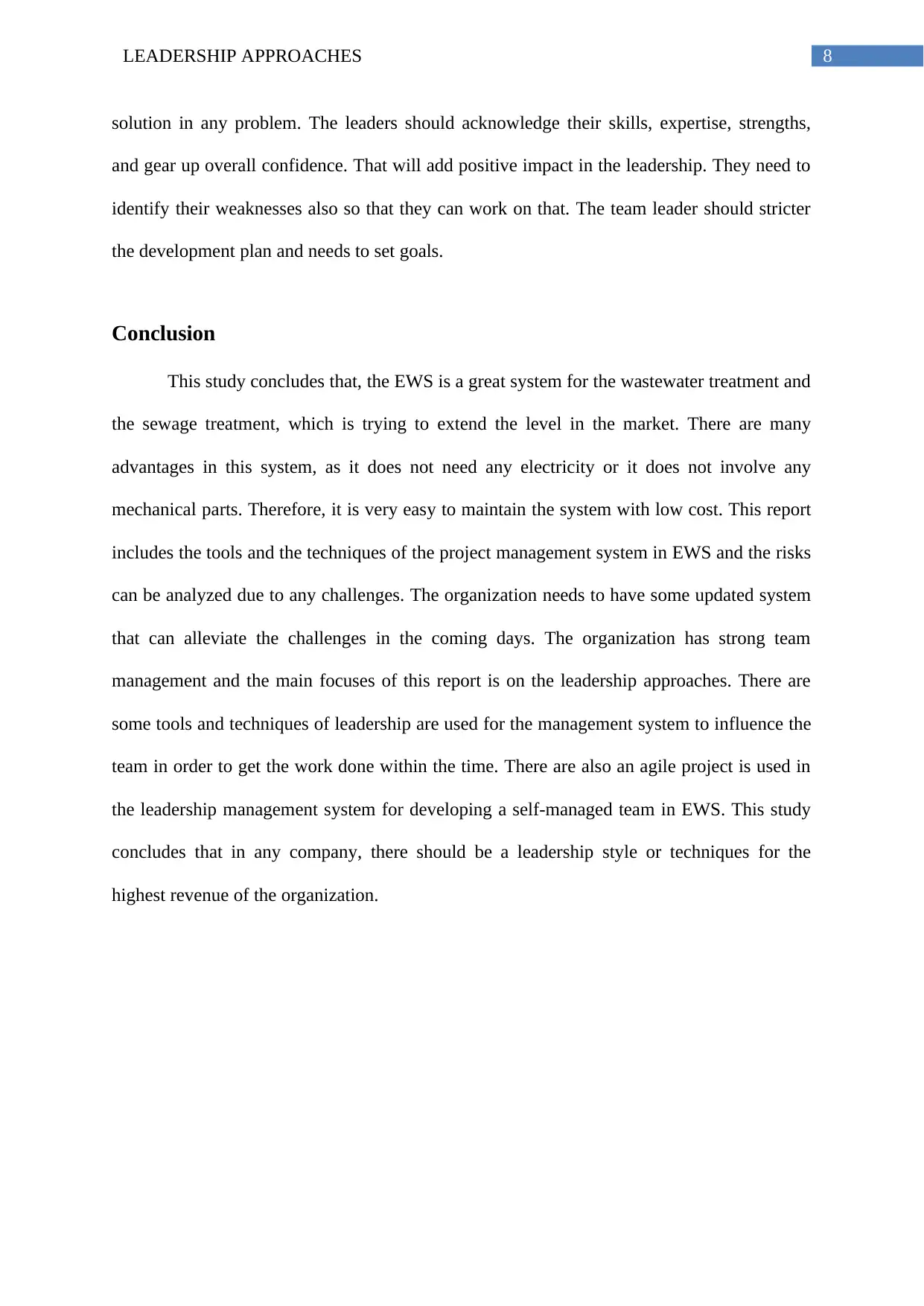
8LEADERSHIP APPROACHES
solution in any problem. The leaders should acknowledge their skills, expertise, strengths,
and gear up overall confidence. That will add positive impact in the leadership. They need to
identify their weaknesses also so that they can work on that. The team leader should stricter
the development plan and needs to set goals.
Conclusion
This study concludes that, the EWS is a great system for the wastewater treatment and
the sewage treatment, which is trying to extend the level in the market. There are many
advantages in this system, as it does not need any electricity or it does not involve any
mechanical parts. Therefore, it is very easy to maintain the system with low cost. This report
includes the tools and the techniques of the project management system in EWS and the risks
can be analyzed due to any challenges. The organization needs to have some updated system
that can alleviate the challenges in the coming days. The organization has strong team
management and the main focuses of this report is on the leadership approaches. There are
some tools and techniques of leadership are used for the management system to influence the
team in order to get the work done within the time. There are also an agile project is used in
the leadership management system for developing a self-managed team in EWS. This study
concludes that in any company, there should be a leadership style or techniques for the
highest revenue of the organization.
solution in any problem. The leaders should acknowledge their skills, expertise, strengths,
and gear up overall confidence. That will add positive impact in the leadership. They need to
identify their weaknesses also so that they can work on that. The team leader should stricter
the development plan and needs to set goals.
Conclusion
This study concludes that, the EWS is a great system for the wastewater treatment and
the sewage treatment, which is trying to extend the level in the market. There are many
advantages in this system, as it does not need any electricity or it does not involve any
mechanical parts. Therefore, it is very easy to maintain the system with low cost. This report
includes the tools and the techniques of the project management system in EWS and the risks
can be analyzed due to any challenges. The organization needs to have some updated system
that can alleviate the challenges in the coming days. The organization has strong team
management and the main focuses of this report is on the leadership approaches. There are
some tools and techniques of leadership are used for the management system to influence the
team in order to get the work done within the time. There are also an agile project is used in
the leadership management system for developing a self-managed team in EWS. This study
concludes that in any company, there should be a leadership style or techniques for the
highest revenue of the organization.
⊘ This is a preview!⊘
Do you want full access?
Subscribe today to unlock all pages.

Trusted by 1+ million students worldwide
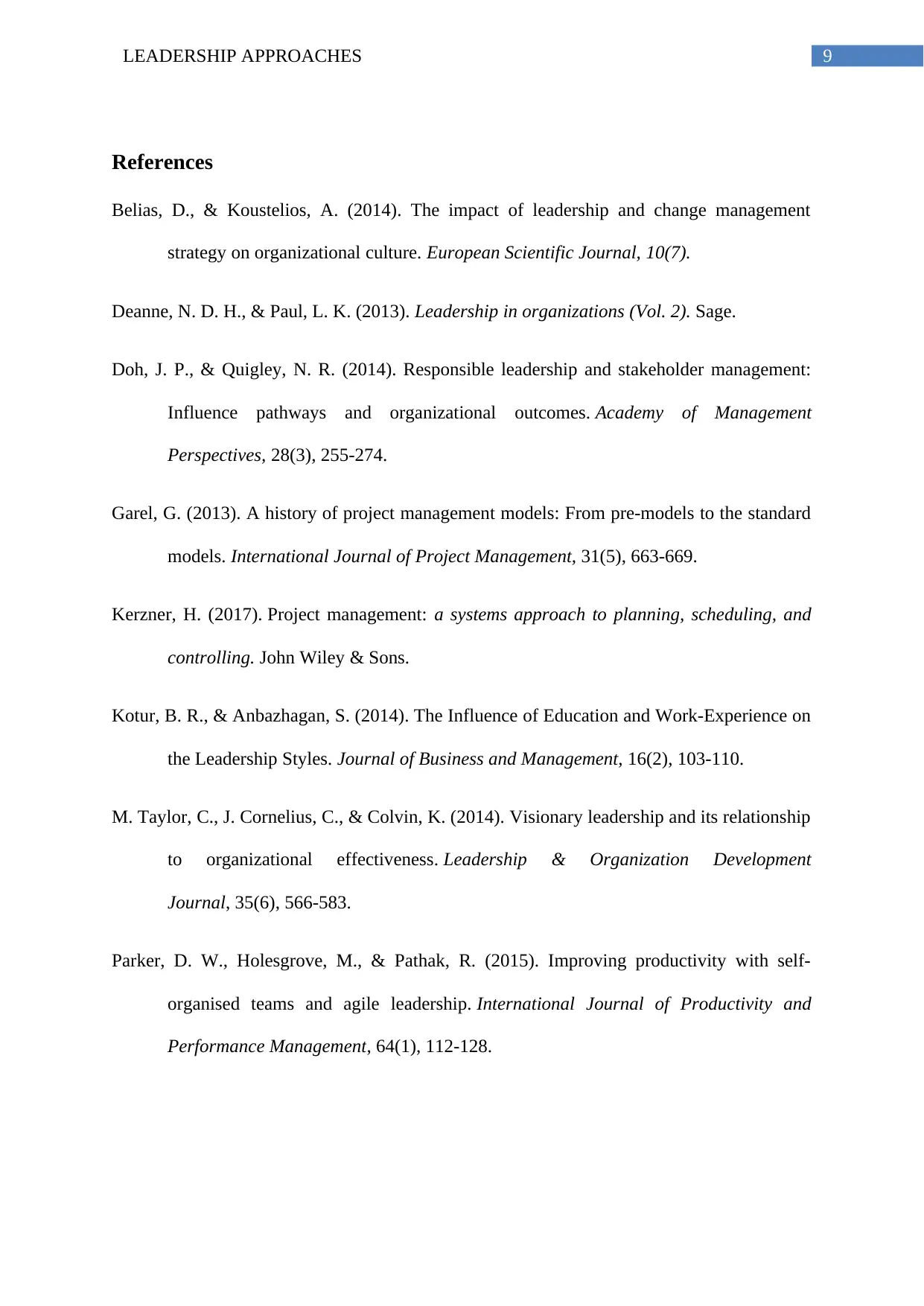
9LEADERSHIP APPROACHES
References
Belias, D., & Koustelios, A. (2014). The impact of leadership and change management
strategy on organizational culture. European Scientific Journal, 10(7).
Deanne, N. D. H., & Paul, L. K. (2013). Leadership in organizations (Vol. 2). Sage.
Doh, J. P., & Quigley, N. R. (2014). Responsible leadership and stakeholder management:
Influence pathways and organizational outcomes. Academy of Management
Perspectives, 28(3), 255-274.
Garel, G. (2013). A history of project management models: From pre-models to the standard
models. International Journal of Project Management, 31(5), 663-669.
Kerzner, H. (2017). Project management: a systems approach to planning, scheduling, and
controlling. John Wiley & Sons.
Kotur, B. R., & Anbazhagan, S. (2014). The Influence of Education and Work-Experience on
the Leadership Styles. Journal of Business and Management, 16(2), 103-110.
M. Taylor, C., J. Cornelius, C., & Colvin, K. (2014). Visionary leadership and its relationship
to organizational effectiveness. Leadership & Organization Development
Journal, 35(6), 566-583.
Parker, D. W., Holesgrove, M., & Pathak, R. (2015). Improving productivity with self-
organised teams and agile leadership. International Journal of Productivity and
Performance Management, 64(1), 112-128.
References
Belias, D., & Koustelios, A. (2014). The impact of leadership and change management
strategy on organizational culture. European Scientific Journal, 10(7).
Deanne, N. D. H., & Paul, L. K. (2013). Leadership in organizations (Vol. 2). Sage.
Doh, J. P., & Quigley, N. R. (2014). Responsible leadership and stakeholder management:
Influence pathways and organizational outcomes. Academy of Management
Perspectives, 28(3), 255-274.
Garel, G. (2013). A history of project management models: From pre-models to the standard
models. International Journal of Project Management, 31(5), 663-669.
Kerzner, H. (2017). Project management: a systems approach to planning, scheduling, and
controlling. John Wiley & Sons.
Kotur, B. R., & Anbazhagan, S. (2014). The Influence of Education and Work-Experience on
the Leadership Styles. Journal of Business and Management, 16(2), 103-110.
M. Taylor, C., J. Cornelius, C., & Colvin, K. (2014). Visionary leadership and its relationship
to organizational effectiveness. Leadership & Organization Development
Journal, 35(6), 566-583.
Parker, D. W., Holesgrove, M., & Pathak, R. (2015). Improving productivity with self-
organised teams and agile leadership. International Journal of Productivity and
Performance Management, 64(1), 112-128.
Paraphrase This Document
Need a fresh take? Get an instant paraphrase of this document with our AI Paraphraser
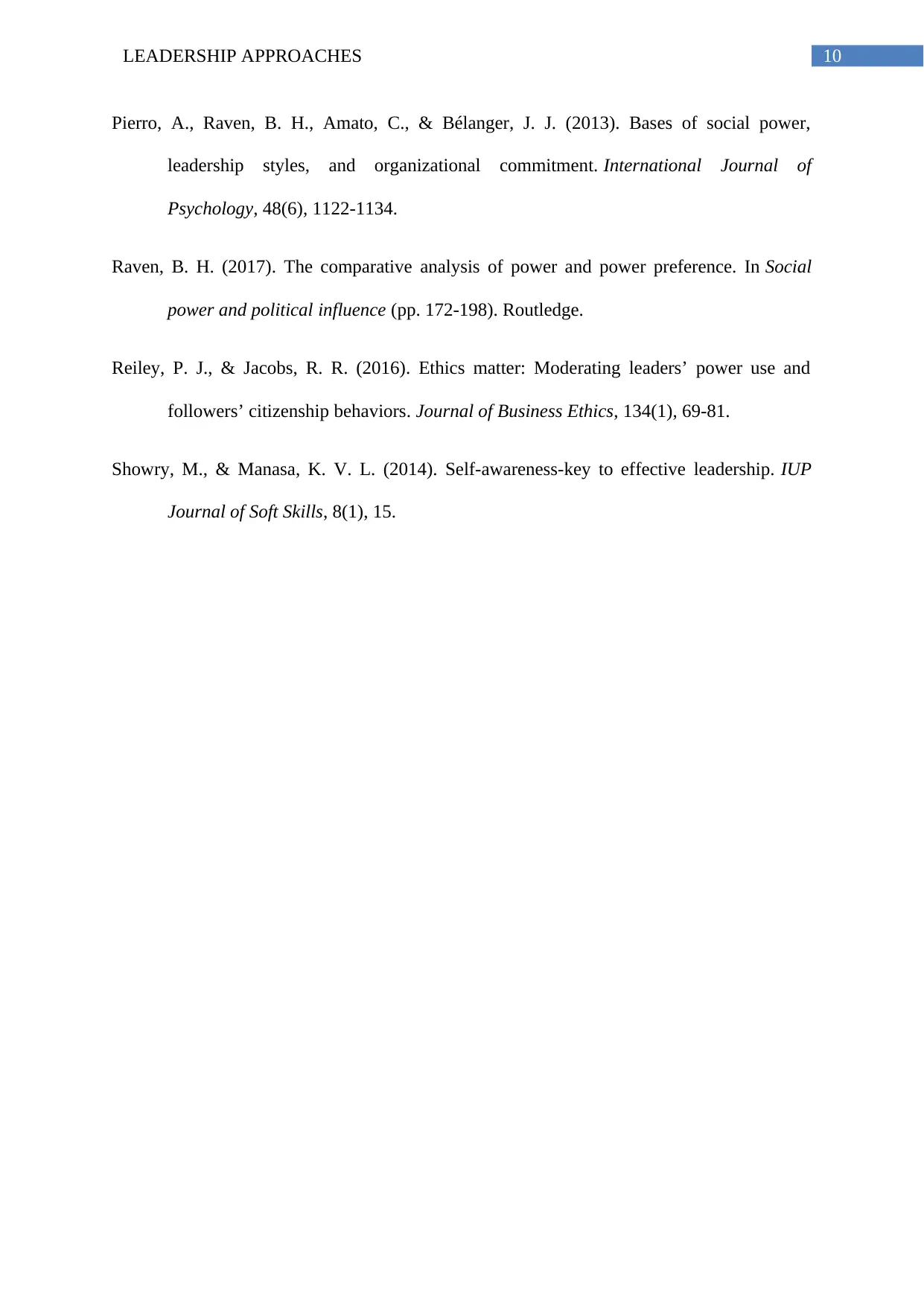
10LEADERSHIP APPROACHES
Pierro, A., Raven, B. H., Amato, C., & Bélanger, J. J. (2013). Bases of social power,
leadership styles, and organizational commitment. International Journal of
Psychology, 48(6), 1122-1134.
Raven, B. H. (2017). The comparative analysis of power and power preference. In Social
power and political influence (pp. 172-198). Routledge.
Reiley, P. J., & Jacobs, R. R. (2016). Ethics matter: Moderating leaders’ power use and
followers’ citizenship behaviors. Journal of Business Ethics, 134(1), 69-81.
Showry, M., & Manasa, K. V. L. (2014). Self-awareness-key to effective leadership. IUP
Journal of Soft Skills, 8(1), 15.
Pierro, A., Raven, B. H., Amato, C., & Bélanger, J. J. (2013). Bases of social power,
leadership styles, and organizational commitment. International Journal of
Psychology, 48(6), 1122-1134.
Raven, B. H. (2017). The comparative analysis of power and power preference. In Social
power and political influence (pp. 172-198). Routledge.
Reiley, P. J., & Jacobs, R. R. (2016). Ethics matter: Moderating leaders’ power use and
followers’ citizenship behaviors. Journal of Business Ethics, 134(1), 69-81.
Showry, M., & Manasa, K. V. L. (2014). Self-awareness-key to effective leadership. IUP
Journal of Soft Skills, 8(1), 15.
1 out of 11
Related Documents
Your All-in-One AI-Powered Toolkit for Academic Success.
+13062052269
info@desklib.com
Available 24*7 on WhatsApp / Email
![[object Object]](/_next/static/media/star-bottom.7253800d.svg)
Unlock your academic potential
Copyright © 2020–2025 A2Z Services. All Rights Reserved. Developed and managed by ZUCOL.




